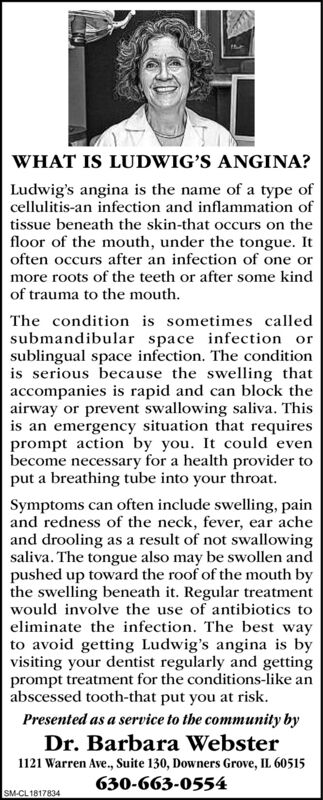Advertisement

-
Published Date
October 28, 2020This ad was originally published on this date and may contain an offer that is no longer valid. To learn more about this business and its most recent offers, click here.
Ad Text
WHAT IS LUDWIG'S ANGINA? Ludwig's angina is the name of a type of cellulitis-an infection and inflammation of tissue beneath the skin-that occurs on the floor of the mouth, under the tongue. It often occurs after an infection of one or more roots of the teeth or after some kind of trauma to the mouth. The condition is sometimes called submandibular space infection or sublingual space infection. The condition is serious because the swelling that accompanies is rapid and can block the airway or prevent swallowing saliva. This is an emergency situation that requires prompt action by you. It could even become necessary for a health provider to put a breathing tube into your throat. Symptoms can often include swelling, pain and redness of the neck, fever, ear ache and drooling as a result of not swallowing saliva. The tongue also may be swollen and pushed up toward the roof of the mouth by the swelling beneath it. Regular treatment would involve the use of antibiotics to eliminate the infection. The best way to avoid getting Ludwig's angina is by visiting your dentist regularly and getting prompt treatment for the conditions-like an abscessed tooth-that put you at risk. Presented as a service to the community by Dr. Barbara Webster 1121 Warren Ave., Suite 130, Downers Grove, IL 60515 630-663-0554 SM-CL 1817834 WHAT IS LUDWIG'S ANGINA? Ludwig's angina is the name of a type of cellulitis-an infection and inflammation of tissue beneath the skin-that occurs on the floor of the mouth, under the tongue. It often occurs after an infection of one or more roots of the teeth or after some kind of trauma to the mouth. The condition is sometimes called submandibular space infection or sublingual space infection. The condition is serious because the swelling that accompanies is rapid and can block the airway or prevent swallowing saliva. This is an emergency situation that requires prompt action by you. It could even become necessary for a health provider to put a breathing tube into your throat. Symptoms can often include swelling, pain and redness of the neck, fever, ear ache and drooling as a result of not swallowing saliva. The tongue also may be swollen and pushed up toward the roof of the mouth by the swelling beneath it. Regular treatment would involve the use of antibiotics to eliminate the infection. The best way to avoid getting Ludwig's angina is by visiting your dentist regularly and getting prompt treatment for the conditions-like an abscessed tooth-that put you at risk. Presented as a service to the community by Dr. Barbara Webster 1121 Warren Ave., Suite 130, Downers Grove, IL 60515 630-663-0554 SM-CL 1817834
